Sunday, May 31, 2009
Beeee, beee beee BEEEE
Not just a silly title; it's my new response to any troublesome stimulus.
And where did I learn this useful skill? Today, when I was doing hive inspections on the three hives, I heard it in the middle hive -- the most confusing to me of all of them. I saw everything (hey, Denise, remember that from "Extras"?) in it. Brood, both drone and worker, eggs, all the sizes of larvae, emerging workers, bee bread, pollen, capped honey, uncapped nectar, comb being drawn, the queen stalking around, an opened queen cell -- with its little cap opening still hanging on -- and four uncapped, unhatched queen cells.
The queen was walking around right by number four. I don't know if she was making the noise or the about-to-emerge challenger, but loudly and distinctly, I heard it: "Beeeeee, beeee beee, beeeeeeeee, beeee beee." It was so loud that it actually drew my attention to the frame.
Tonight, when I was researching this, I found, in Rex Boyes' "Listen to the Bees:"
"When I talk to an audience, I always ask for a show of hands of who has actually heard queen piping and the result is usually about 50% of the beekeepers present. Then I ask who reckons to hear it at least once every year and further questioning establishes that all these people have more than 20 hives. This is more or less in line with my own experience; with an average of 8 hives over 20 years, I have heard it just 3 times. What this means is that an average beekeeper with 2 hives is likely to hear it once every 25 years! Clearly it is a pretty rare phenomenon.
Piping is the sound a queen makes when she detects the proximity of another queen and the words used to describe it are bleating, honking, croaking or mewing. For my money, the nearest sound I can think of is the crying of seagulls when they are competing for your sandwiches. The only time you get two queens in the hive is around swarming and they will usually be virgins that have emerged after the swarm has left. Imagine the difficulty in carrying out research on a sound that in any particular hive, occurs for only a few days in every one or two years!"
There you have it; lucky me. So today, not only do I wish I had had my camera with me, I wish I had the video recorder too. Since I didn't, I'd be happy to make the noise for anyone who asks from now on.
Saturday, May 30, 2009
Weighing our choices
We love kale, and right now it’s the happiest thing in the garden, covering about a third of one 25-foot bed.
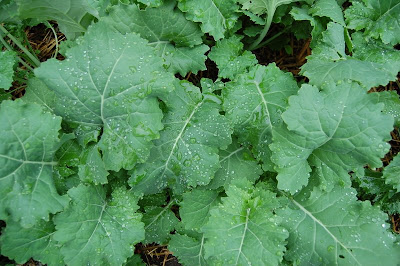 The other night before bed we decided to pull three whole plants because they were shading some little broccoli. And here they are:
The other night before bed we decided to pull three whole plants because they were shading some little broccoli. And here they are:

In two large pots of boiling water, we blanched it in about 8 batches, soaked it in ice water and strained and bagged it into this:

Altogether it took two (grown but very tired) people 45 minutes to 1 hour, 10 to12 gallons of water, and the natural gas of the stove to bring the kale from garden to storage, where it will use the energy of the freezer.
But then we have to figure the time and energy---fueled or not---to get to the farmers’ market and the fuel used to transport the food from farm to market, etc etc.



In two large pots of boiling water, we blanched it in about 8 batches, soaked it in ice water and strained and bagged it into this:
Altogether it took two (grown but very tired) people 45 minutes to 1 hour, 10 to12 gallons of water, and the natural gas of the stove to bring the kale from garden to storage, where it will use the energy of the freezer.
But then we have to figure the time and energy---fueled or not---to get to the farmers’ market and the fuel used to transport the food from farm to market, etc etc.
Finish Line in Sight
Sometimes I wonder if folks get tired of slow as molasses knitting pictures. I know I prefer ones where it seems as though the knitter has a bunch of "Shoemaker and the Elves" helpers, buying yarn and then having it seem to magically knit itself up into exquisitely finished garments, presto-changeo.
My knitting is not like that. I don't knit much, and I knit slowly. This is a theme in my life, apparently.
But, even a slow knitter makes progress. Sometimes, that progress is even serendipitous. For instance, when I chose to knit the sleeves for my current project at the same time, planning to steek and sew them later, it was to make the color runs approximately the same size as the body.
I didn't know they would also be a close match.

And why am I so tired, you might wonder? Remember how I don't think I knit much or fast? Well, I know for a fact that I don't run much, and that not very fast.
Nevertheless, I ran my first (and perhaps last) 5k today with two really good buddies. Even with approximately 2500 other women running, it felt like it was just us, and Eric and Caterina, who came out to cheer me on. The slower of us in the threesome had dubbed today the "Chasing Grace" day, and it was. I lost her quickly at the beginning and never caught up. I know I ran a faster first mile than I would have thought, because I heard someone call the time. I paid for it, and finished the race with an average of (wait for it) -- ten minutes a mile! So a fast first, slow second and medium third. Sheesh. I could have done that without the crowds and tags and electronic timing.
Oh well. I figured I deserved a little something (although the free massages afterward were wonderful), so I drove my friend's yarn store and picked up some treats for my feet.
My knitting is not like that. I don't knit much, and I knit slowly. This is a theme in my life, apparently.
But, even a slow knitter makes progress. Sometimes, that progress is even serendipitous. For instance, when I chose to knit the sleeves for my current project at the same time, planning to steek and sew them later, it was to make the color runs approximately the same size as the body.
I didn't know they would also be a close match.
And now, despite having absolutely zero elves of the helpful-in-handwork category, the sleeves are almost done.
All that's left is to bind off the steek stitches, and then figure out whether to connect the remaining stitches into two separate rounds, and knit the cuffs before cutting the steeks, or cut the steeks, sew the sleeves into tubes, and then knit the cuffs. I think I had better ask around -- I'm tired and can't quite figure out what order to do them. I want it to be done well ahead of the fair, but also done well.
Nevertheless, I ran my first (and perhaps last) 5k today with two really good buddies. Even with approximately 2500 other women running, it felt like it was just us, and Eric and Caterina, who came out to cheer me on. The slower of us in the threesome had dubbed today the "Chasing Grace" day, and it was. I lost her quickly at the beginning and never caught up. I know I ran a faster first mile than I would have thought, because I heard someone call the time. I paid for it, and finished the race with an average of (wait for it) -- ten minutes a mile! So a fast first, slow second and medium third. Sheesh. I could have done that without the crowds and tags and electronic timing.
Oh well. I figured I deserved a little something (although the free massages afterward were wonderful), so I drove my friend's yarn store and picked up some treats for my feet.
Finish Line in Sight
Sometimes I wonder if folks get tired of slow as molasses knitting pictures. I know I prefer ones where it seems as though the knitter has a bunch of "Shoemaker and the Elves" helpers, buying yarn and then having it seem to magically knit itself up into exquisitely finished garments, presto-changeo.
My knitting is not like that. I don't knit much, and I knit slowly. This is a theme in my life, apparently.
But, even a slow knitter makes progress. Sometimes, that progress is even serendipitous. For instance, when I chose to knit the sleeves for my current project at the same time, planning to steek and sew them later, it was to make the color runs approximately the same size as the body.
I didn't know they would also be a close match.

And why am I so tired, you might wonder? Remember how I don't think I knit much or fast? Well, I know for a fact that I don't run much, and that not very fast.
Nevertheless, I ran my first (and perhaps last) 5k today with two really good buddies. Even with approximately 2500 other women running, it felt like it was just us, and Eric and Caterina, who came out to cheer me on. The slower of us in the threesome had dubbed today the "Chasing Grace" day, and it was. I lost her quickly at the beginning and never caught up. I know I ran a faster first mile than I would have thought, because I heard someone call the time. I paid for it, and finished the race with an average of (wait for it) -- ten minutes a mile! So a fast first, slow second and medium third. Sheesh. I could have done that without the crowds and tags and electronic timing.
Oh well. I figured I deserved a little something (although the free massages afterward were wonderful), so I drove my friend's yarn store and picked up some treats for my feet.
My knitting is not like that. I don't knit much, and I knit slowly. This is a theme in my life, apparently.
But, even a slow knitter makes progress. Sometimes, that progress is even serendipitous. For instance, when I chose to knit the sleeves for my current project at the same time, planning to steek and sew them later, it was to make the color runs approximately the same size as the body.
I didn't know they would also be a close match.
And now, despite having absolutely zero elves of the helpful-in-handwork category, the sleeves are almost done.
All that's left is to bind off the steek stitches, and then figure out whether to connect the remaining stitches into two separate rounds, and knit the cuffs before cutting the steeks, or cut the steeks, sew the sleeves into tubes, and then knit the cuffs. I think I had better ask around -- I'm tired and can't quite figure out what order to do them. I want it to be done well ahead of the fair, but also done well.
Nevertheless, I ran my first (and perhaps last) 5k today with two really good buddies. Even with approximately 2500 other women running, it felt like it was just us, and Eric and Caterina, who came out to cheer me on. The slower of us in the threesome had dubbed today the "Chasing Grace" day, and it was. I lost her quickly at the beginning and never caught up. I know I ran a faster first mile than I would have thought, because I heard someone call the time. I paid for it, and finished the race with an average of (wait for it) -- ten minutes a mile! So a fast first, slow second and medium third. Sheesh. I could have done that without the crowds and tags and electronic timing.
Oh well. I figured I deserved a little something (although the free massages afterward were wonderful), so I drove my friend's yarn store and picked up some treats for my feet.
Thursday, May 28, 2009
Garden Soundtrack
Most days, the garden is a haven of peace. I can hear the chickens clucking, the bees buzzing, the distant traffic, sometimes the sound of a piano being played inside, but it's pretty quiet, relatively speaking.
Then there are mornings like this one, when I'm wearing portable music. It was as though someone from a movie had made up the list -- Bonnie Raitt's "Angel from Montgomery," to remind me that I'm going to get old, but dreams go on and on; the mystic musings of The Waterboys, because soil and water and sun make magic that can be approached but not ever mastered; the screaming political Irish speed punk of Flogging Molly, a call to activism, and I certainly count growing food and reusing water as activist acts, albeit quiet ones; and finishing up, U2's "Wild Honey," that paean to desire and sweetness.
And I danced wildly past the beans and tomatoes, twirled around the zinnias, and air-guitared by the basil, and reflected that quiet and peace have their place, but so do pounding pulsing beats.
I send you flowers
Could flowers thaw you heart
I know your garden is full
But is there sweetness at all . . .
Wednesday, May 27, 2009
Supporting Cast
I was inspired by Dan's recent post about his move to compostable supports for his plants to get out and photograph my supports for this year's garden. As with most gardeners, everything is a work in progress, but I make refinements as I go along. For pole beans, the problem is getting them tall enough. This year, 8' long redwood 1x1s seemed to be the answer. They're tall, even after stuffing them in the garden bed, and a quick screw or two to the back fence helped make them even more sturdy. Quite possibly as sturdy as this fence! The corners might have a screw in place (thank goodness for an electric drill) but I think I also might have just tied some in place. This one has both. A few turns around and a square knot, and it's the horizontal upper piece in place.
Along the bottom, above the soil level, I tied a long piece of the compostable twine. At intervals, it's held down by pins made from wire hangers, so it's relatively stable, just at the beginning. Over the horizontal bar, I just tossed the ball of twine so there are V-shaped loops hanging down.
One of the Scarlet Runner beans is as tall as me if I'm on the ground, so it's got to be up about 4-5' from its start. Too bad I transplanted a whack of bush beans along one section of trellis!
The beans aren't the only plants with partially-compostable supports. Tomato cages give me fits. If they're the stacking round ones, they're generally not sturdy enough for big, indeterminate varieites, and the sturdy round cages I make myself are a storage nightmare. If I had a barn or something, I'd just do that but on a small, urban lot, storage is a key consideration.
This year, I tried an idea I've been percolating for some time. The 6" square concrete reinforcing wire that comes in big sheets makes a nice "alley" put up with sections of rebar.
I figure, at the end of the season, I'll pull out the sticks, and hang the still-flat wire along a fence. Worth a try, at least.
The hot weather has had the bees out in force, drinking from the new "fountain," (really an old refrigerator drawer with water and bits of wood for landing platforms in it) a lot. It gets near constant traffic. Click for a closeup of her tongue.
Unfortunately, the friendly, useful bees aren't the only visitors to the garden. Does anyone know a good purpose for yellow jackets?
Sunday, May 24, 2009
Picking and Choosing
There has been absolutely so much going on that I can't keep up. I'm lucky if I jot notes down in my garden journal. Can I put there that my son has lost his first two teeth and remember it? I've given up on being the kind of parent who writes down the funny things they say; the least I can do is keep track of big milestones.
One milestone seemed to happen really quickly here. After the chickens were put on restriction, we had to make them a new, contained container.
On one of the hottest days in the year so far, Eric thought it would be a nice chance to practice some fancy Japanese-style joinery.


I got to dig holes. Being the unskilled labor kind of stinks. Thank goodness for sandy soil.
In one week, we went from tank tops and buckets of sweat to sweaters under jackets. The coop area went from a prison to this nice (although sorely in need of painting -- maybe I'll think of a way to indulge my wanna-be muralist side), but more importantly, secure, coop. It was finished on a raw, cold pair of days.
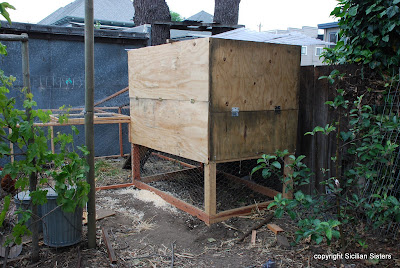
The old coop was big enough to walk in, but this one has a hatch that serves for both egg removal and clean out -- we raised the nest boxes just above a the height of a rake.
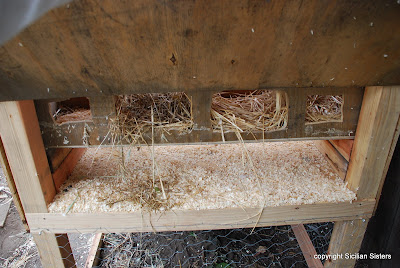
The old coop had a dirt floor, which meant it was filled with dust-covered spiderwebs. Now that old coop is only a pile of needing-to-be-sorted-and-reused lumber and screen.

A side panel lifts for food and water changing. We're still working on securing the roof, made from almost-clear panels for more light, and the food will be suspended from one of the wooden supports for that. There's got to be a better way to secure the water, also. The roof will ideally have some hardware-cloth screened vents on each end, since the coop is so tight. When the little girls get in there too, there's going to be a lot of body heat inside.

There's a hatch in the pen for scrap and weed and other chicken amuse-bouches, and the little ramp ladder leads to a door that slides, guillotine-style.

And, we got it done in time for the first city bicycle coop tour today! What seemed like a whole bunch of us roamed around and visited seven different coops.


It was interesting to see the different approaches folks have to the issues of safety, convenience, health, and access. I bet there are many more coops on our little island -- maybe next year the Tour de Coop will be even bigger.
The chickens at our house seemed to greatly appreciate their new digs. What's this pile of damp feathers? Why, it's Gondor the hen -- I didn't think she was going to leave that dirt bath all day long.



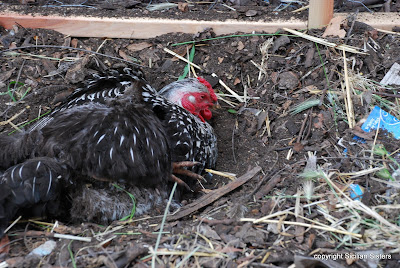
But not only did she, by the time I went out to lower the door after a day full of friends and good times, I heard only quiet contented clucking from the hens, all arrayed on their perches for the night.
One milestone seemed to happen really quickly here. After the chickens were put on restriction, we had to make them a new, contained container.
On one of the hottest days in the year so far, Eric thought it would be a nice chance to practice some fancy Japanese-style joinery.


I got to dig holes. Being the unskilled labor kind of stinks. Thank goodness for sandy soil.
In one week, we went from tank tops and buckets of sweat to sweaters under jackets. The coop area went from a prison to this nice (although sorely in need of painting -- maybe I'll think of a way to indulge my wanna-be muralist side), but more importantly, secure, coop. It was finished on a raw, cold pair of days.

The old coop was big enough to walk in, but this one has a hatch that serves for both egg removal and clean out -- we raised the nest boxes just above a the height of a rake.

The old coop had a dirt floor, which meant it was filled with dust-covered spiderwebs. Now that old coop is only a pile of needing-to-be-sorted-and-reused lumber and screen.

A side panel lifts for food and water changing. We're still working on securing the roof, made from almost-clear panels for more light, and the food will be suspended from one of the wooden supports for that. There's got to be a better way to secure the water, also. The roof will ideally have some hardware-cloth screened vents on each end, since the coop is so tight. When the little girls get in there too, there's going to be a lot of body heat inside.

There's a hatch in the pen for scrap and weed and other chicken amuse-bouches, and the little ramp ladder leads to a door that slides, guillotine-style.

And, we got it done in time for the first city bicycle coop tour today! What seemed like a whole bunch of us roamed around and visited seven different coops.


It was interesting to see the different approaches folks have to the issues of safety, convenience, health, and access. I bet there are many more coops on our little island -- maybe next year the Tour de Coop will be even bigger.
The chickens at our house seemed to greatly appreciate their new digs. What's this pile of damp feathers? Why, it's Gondor the hen -- I didn't think she was going to leave that dirt bath all day long.




But not only did she, by the time I went out to lower the door after a day full of friends and good times, I heard only quiet contented clucking from the hens, all arrayed on their perches for the night.
Friday, May 22, 2009
Tubers
The two pounds of organic Yellow Finn seed potatoes showed up yesterday, and since I had the beginnings of their tower (really a repurposed stacking compost bin) all ready, out they went. Even late is better than never, I assume.
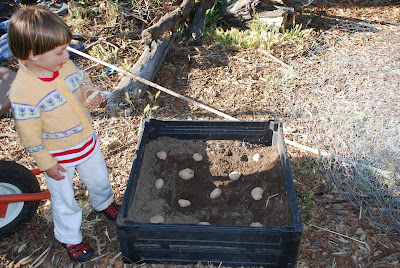
As the plants grow, I'll add more soil and more bin parts -- there's enough to go pretty high.
It's going to be fun to see how many pounds we end up with when they're all done.

As the plants grow, I'll add more soil and more bin parts -- there's enough to go pretty high.
It's going to be fun to see how many pounds we end up with when they're all done.
Wednesday, May 20, 2009
Cherry Days
Partly in honor of our mother's visit, and partly to celebrate the local harvest possibilities, we took our kids plus one

 out to a nearby town to pick cherries yesterday. Fortunately for us, the weekend's heat spike had been replaced by more seasonable weather, so it was just hot out there, not "blistering."
out to a nearby town to pick cherries yesterday. Fortunately for us, the weekend's heat spike had been replaced by more seasonable weather, so it was just hot out there, not "blistering."

In what seemed like a very limited time, we picked well over 20 pounds of lovely early sweet cherries.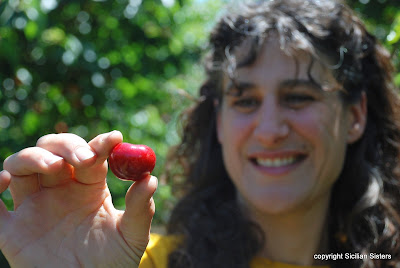
Those who didn't pick found plenty to occupy their time. After all the cherries had been picked, all the older kids had been annoyed by younger ones, nearly everyone had eaten too many cherries, and we were wiped out, we headed back home.

There they got sorted into "use immediately," "will keep longer" and "make into jam" piles. Denise called to ask how I processed them and I made a plug for processing them by putting them into the stomachs of our neighbors. That's one of my favorite approaches to bounty.
I finally got a chance to try something from Mes Confitures, and made a discovery. The very thing that makes the recipes annoying to me in general -- their rather "puttery" nature -- is perfect for the kind of exhaustion following a hot day out with lots of family. I chopped and macerated, smashed and simmered and popped a piece of parchment on top and then the mixture and I went to bed in our respective places.
After Eric left for work, but before anyone else was fully functional (thank you, Fed Ex, for calling my house twice at 6:20 am), I had the jam processed and the jars cooling. We'll see how they taste.


 out to a nearby town to pick cherries yesterday. Fortunately for us, the weekend's heat spike had been replaced by more seasonable weather, so it was just hot out there, not "blistering."
out to a nearby town to pick cherries yesterday. Fortunately for us, the weekend's heat spike had been replaced by more seasonable weather, so it was just hot out there, not "blistering."
In what seemed like a very limited time, we picked well over 20 pounds of lovely early sweet cherries.

Those who didn't pick found plenty to occupy their time. After all the cherries had been picked, all the older kids had been annoyed by younger ones, nearly everyone had eaten too many cherries, and we were wiped out, we headed back home.

There they got sorted into "use immediately," "will keep longer" and "make into jam" piles. Denise called to ask how I processed them and I made a plug for processing them by putting them into the stomachs of our neighbors. That's one of my favorite approaches to bounty.
I finally got a chance to try something from Mes Confitures, and made a discovery. The very thing that makes the recipes annoying to me in general -- their rather "puttery" nature -- is perfect for the kind of exhaustion following a hot day out with lots of family. I chopped and macerated, smashed and simmered and popped a piece of parchment on top and then the mixture and I went to bed in our respective places.
After Eric left for work, but before anyone else was fully functional (thank you, Fed Ex, for calling my house twice at 6:20 am), I had the jam processed and the jars cooling. We'll see how they taste.

Friday, May 15, 2009
I am knitting
But who wants to see pictures of 1/3 of a pair of sleeves?
In order to ensure that I get this monster done, the Alameda County Fair is going to expect me to be there on the 13th of June with it finished to submit it for judging. I don't expect much, but a) it's fun to enter things and b) I get a free ticket for everything I enter, I think. Since one of our favorite bands is playing there -- I know, is there anything more pathetic than the fair circuit? -- we're looking forward to a night out.
I am, however, doing lots of stuff on the gardening blog. See you there if you'd like, otherwise stay tuned. Pictures of finished sleeves next time, I promise.
In order to ensure that I get this monster done, the Alameda County Fair is going to expect me to be there on the 13th of June with it finished to submit it for judging. I don't expect much, but a) it's fun to enter things and b) I get a free ticket for everything I enter, I think. Since one of our favorite bands is playing there -- I know, is there anything more pathetic than the fair circuit? -- we're looking forward to a night out.
I am, however, doing lots of stuff on the gardening blog. See you there if you'd like, otherwise stay tuned. Pictures of finished sleeves next time, I promise.
In the key of bee
Quick notes, so I don't forget what happened when. I went out into the other hive today, the one that didn't get combined with the marked queen-hive, to see what was going on. The bees have been crowding the entrance board lately, and I was wondering what was up. Apologies to those of you who just don't care; I tend to forget later on and wonder what is up with the hives, so getting it down while the memory is fresh is important. I also don't have any pictures of this part -- it's difficult to take my own, and I couldn't talk any of the children, sick or well, into wielding a camera for posterity.
So, I pulled off the honey super and set it aside to deal with later. The top deep brood box was full-to-boiling with bees, and I set it aside. It was very very heavy, and I lifted it on top of my work area, the small chicks' coop. Ugh.
Then, frame by frame, I went through the bottom box. Lots of drone brood, but not completely drone brood. Just. . . a lot. Also, a sealed queen cell. I don't know if they're planning to swarm or what, so I left it. I've never seen any of them sealed, just usually post-exit. This may have been a mistake. I don't know. This box was also stuffed to the brim with bees. Many bees. Bees who weren't thrilled about me doing this. I pulled one frame that was all capped drone brood, built on a non-foundation comb. That frame got set aside to give to the imprisoned hens for later.
It also got replaced with one empty frame of deep foundation comb. It looks as though this nest needs expansion space, as every frame except one half-finished honey is brood or capped brood.
Slapped a cover on that box, and did the same routine with the second brood box. Lots of brood, but not a perfect laying pattern. Just -- brood. This level had the "rainbow' of honey and pollen that the bees store over the laying nest, to feed the growing brood. Couple of open queen cells, and that was it. I may have found a new frame for this one, too, but I'm not sure of that.
Then, last, the honey super. Whee! Honey, I thought. And there was a LOT of nicely-drawn comb. Just pretty stuff. However, there were also many sealed brood cells in the middle of these frames! A queen has been wandering into my honey super. I was indignant. I've never used a queen excluder, because, quite frankly, the bees have been so loath to draw comb up there I didn't want to do anything to discourage them. However, it was right there, so I snatched it up and put it on the top brood box, then I thought. What if the queen (remember, this one isn't marked) is in that super right now?
So I went through and shook every frame clear of bees, over the brood box, after lifting up the excluder. If she was up there, she should be in the bottom. If she wasn't, I just offended half a hive of worker bees who were already unhappy with my ministrations. Put the super back, and then I took an empty deep I had with open comb, and put it on top. If they store honey up there, it will be a lot. If they don't, no harm done.
Why did I have empty comb, you ask?
Because last night, this beauty came to visit.
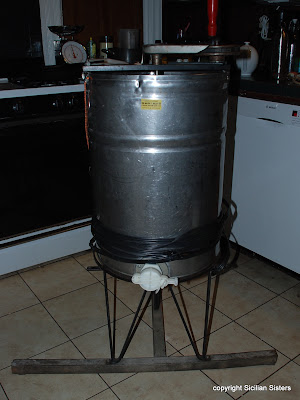
I borrowed it from the bee club. Complete with warming cable, which makes evening extracting more pleasant. I had to borrow it sort of quickly because the ants had found my full-of-honey frames I'd had sitting in my kitchen for a week, dithering about whether or not to purchase an extractor, do crush & strain, or borrow one. Once they had formed a wide column of happy ants, I realized I couldn't wait much more. Fortunately, this one was open. $10 gets you three days with a nice extractor and some accessories. One of the benefits of belonging to a group like this.
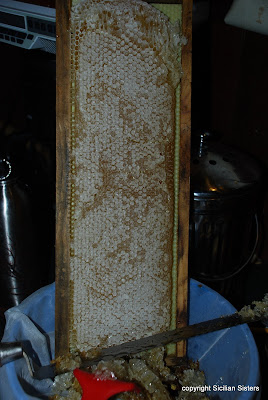
The beautiful comb looked like this. The capping knife swept through, leaving a bunch of honey behind and dropping the drippy cappings into my straining bag. Not all the comb was this pretty or this amenable to slicing, however. For the wonky comb, I have a cappings scratcher:

I could go through and get the caps off of the honey, leaving the open comb or the weirdly-shaped comb behind. This is the kind of frame I returned to the bees today.
Spinning the extractor has its pleasures. I particularly enjoyed getting some help. The kids were all either asleep or out at a class. Just me, the extractor, and my honey. Heeeee. This is actually true love, because Eric doesn't care for honey and hates being sticky (notice the hand carefully in the pocket. No honey for him, thanks). Fun machine, though.
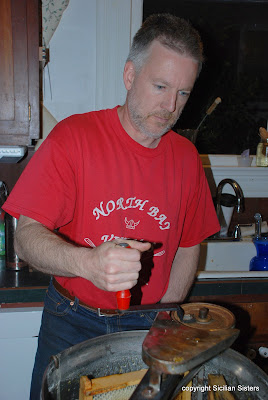
Because he was willing to crank, I got to see the honey being flung out of the comb. It never seems like much at a time, but it does add up.

Finally, I opened the gate at the bottom. Honey and scratched wax came rolling out like a golden river of goodness.
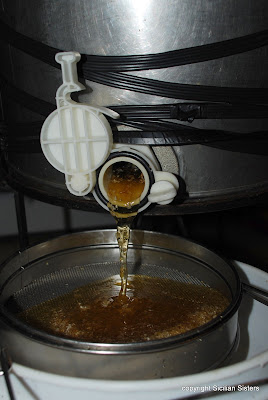
The double filter took out the wax bits, any bee parts, any big clumps of pollen, and any ants that had made it through. The bottom barrel also had a spigot, so when it was all done, I filled up eight of these.

At current prices, jars like this are going for about $14 each (actually for a little less weight) so we bottled at least $112 worth of honey, if I want to keep that record. If it was by pound, the amount goes up to about $140. I have always said that beekeeping is the food activity that breaks even fastest here. That would be even more true with a good harvest. Maybe later this year. For now, I have eight jars where before I had none, and I've learned another skill.
So, I pulled off the honey super and set it aside to deal with later. The top deep brood box was full-to-boiling with bees, and I set it aside. It was very very heavy, and I lifted it on top of my work area, the small chicks' coop. Ugh.
Then, frame by frame, I went through the bottom box. Lots of drone brood, but not completely drone brood. Just. . . a lot. Also, a sealed queen cell. I don't know if they're planning to swarm or what, so I left it. I've never seen any of them sealed, just usually post-exit. This may have been a mistake. I don't know. This box was also stuffed to the brim with bees. Many bees. Bees who weren't thrilled about me doing this. I pulled one frame that was all capped drone brood, built on a non-foundation comb. That frame got set aside to give to the imprisoned hens for later.
It also got replaced with one empty frame of deep foundation comb. It looks as though this nest needs expansion space, as every frame except one half-finished honey is brood or capped brood.
Slapped a cover on that box, and did the same routine with the second brood box. Lots of brood, but not a perfect laying pattern. Just -- brood. This level had the "rainbow' of honey and pollen that the bees store over the laying nest, to feed the growing brood. Couple of open queen cells, and that was it. I may have found a new frame for this one, too, but I'm not sure of that.
Then, last, the honey super. Whee! Honey, I thought. And there was a LOT of nicely-drawn comb. Just pretty stuff. However, there were also many sealed brood cells in the middle of these frames! A queen has been wandering into my honey super. I was indignant. I've never used a queen excluder, because, quite frankly, the bees have been so loath to draw comb up there I didn't want to do anything to discourage them. However, it was right there, so I snatched it up and put it on the top brood box, then I thought. What if the queen (remember, this one isn't marked) is in that super right now?
So I went through and shook every frame clear of bees, over the brood box, after lifting up the excluder. If she was up there, she should be in the bottom. If she wasn't, I just offended half a hive of worker bees who were already unhappy with my ministrations. Put the super back, and then I took an empty deep I had with open comb, and put it on top. If they store honey up there, it will be a lot. If they don't, no harm done.
Why did I have empty comb, you ask?
Because last night, this beauty came to visit.

I borrowed it from the bee club. Complete with warming cable, which makes evening extracting more pleasant. I had to borrow it sort of quickly because the ants had found my full-of-honey frames I'd had sitting in my kitchen for a week, dithering about whether or not to purchase an extractor, do crush & strain, or borrow one. Once they had formed a wide column of happy ants, I realized I couldn't wait much more. Fortunately, this one was open. $10 gets you three days with a nice extractor and some accessories. One of the benefits of belonging to a group like this.

The beautiful comb looked like this. The capping knife swept through, leaving a bunch of honey behind and dropping the drippy cappings into my straining bag. Not all the comb was this pretty or this amenable to slicing, however. For the wonky comb, I have a cappings scratcher:

I could go through and get the caps off of the honey, leaving the open comb or the weirdly-shaped comb behind. This is the kind of frame I returned to the bees today.
Spinning the extractor has its pleasures. I particularly enjoyed getting some help. The kids were all either asleep or out at a class. Just me, the extractor, and my honey. Heeeee. This is actually true love, because Eric doesn't care for honey and hates being sticky (notice the hand carefully in the pocket. No honey for him, thanks). Fun machine, though.

Because he was willing to crank, I got to see the honey being flung out of the comb. It never seems like much at a time, but it does add up.

Finally, I opened the gate at the bottom. Honey and scratched wax came rolling out like a golden river of goodness.

The double filter took out the wax bits, any bee parts, any big clumps of pollen, and any ants that had made it through. The bottom barrel also had a spigot, so when it was all done, I filled up eight of these.

At current prices, jars like this are going for about $14 each (actually for a little less weight) so we bottled at least $112 worth of honey, if I want to keep that record. If it was by pound, the amount goes up to about $140. I have always said that beekeeping is the food activity that breaks even fastest here. That would be even more true with a good harvest. Maybe later this year. For now, I have eight jars where before I had none, and I've learned another skill.
Thursday, May 14, 2009
"The smell of new mown hay"
That's what my dad said every time he mowed our lawn. Since we were in Southern California, that lawn was probably Bermuda grass (my #1 garden menace) and it required a lot of sprinkler use. I remember lots of sprinkler repair! It was a good smell, one that I enjoyed even more when I lived in the southeast and we didn't have to water to have a green and springy yard. Of course, by then I was the mower and it wasn't as much fun.
When we lived in Arizona, we didn't want to use precious water on a lawn, so our front yard closely mirrored the desert around us. It bloomed after winter rains and was cactus alone the rest of the year. I missed the green of the southeast then.
[Even there, though, I spent most of my time and effort on food gardening. Once, I called the Agricultural Extension agent to ask when I should cut back my artichokes for the year, as they weren't cooperatively showing me by dying back. The agent told me, "You can't grow artichokes here." I had to laugh, and asked if she'd like to come out and see my 6x6' specimens and tell them that.]
Now that I'm back in a water-challenged area, I'm still focused on food production. I don't want to put in the work that grass requires. Fortunately, I have other labor for lawn care. Since that other labor insists that the bit of lawn we have is necessary for games, it stays, at least for now.

Out front, though, in our "public" face, it's a different story. Both for aesthetic reasons -- I find food gardens really beautiful -- and for leading by example reasons, nearly all of our front yard is edibles.

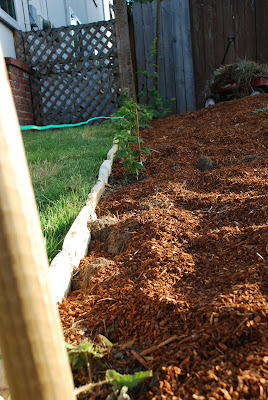 On the west side, persimmon and apricot trees, a future hedge of rasp-and blackberries, and currently a few different kinds of winter squash (and maybe a mistakenly-planted yellow crookneck). This side has more shade from the street tree, but we're thinking of judicious pruning to allow more light in. Maybe we'll put a herb hedge along the front edge, also. For now, though, this one's done except for watering and getting those young trees through their first couple of years.
On the west side, persimmon and apricot trees, a future hedge of rasp-and blackberries, and currently a few different kinds of winter squash (and maybe a mistakenly-planted yellow crookneck). This side has more shade from the street tree, but we're thinking of judicious pruning to allow more light in. Maybe we'll put a herb hedge along the front edge, also. For now, though, this one's done except for watering and getting those young trees through their first couple of years.

The east side is more established. We're also enjoying it a lot these days -- afternoons are spent reading in the hammock, and tea on the porch is a nice morning ritual. There are lemons and limes, espaliered apples,
 bay, rosemary, the artichokes of course, an apricot, a rose, lavender, two varieties of culinary sage, oregano (not the best cooking varieties, as they have insipid aroma and taste), wisteria, and some jasmine that smells terrific. Currently, there's also some pumpkins and cantaloupe, and I'd like to shoehorn in a few watermelon plants this year also.
bay, rosemary, the artichokes of course, an apricot, a rose, lavender, two varieties of culinary sage, oregano (not the best cooking varieties, as they have insipid aroma and taste), wisteria, and some jasmine that smells terrific. Currently, there's also some pumpkins and cantaloupe, and I'd like to shoehorn in a few watermelon plants this year also.

A wild mix of three different kinds of mint -- spearmint, variegated, and chocolate. The parkway edge along the sidewalk is the perfect place for such invasive varieties. I do, however, wash it well because of the interest shown in it by passing dogs. I love smelling it after we brush against it getting in the car.
When I compare our yard with the lawn to the west, it feels much more alive, much more enticing. Passers-by comment on the plants, and people enjoy watching as the seasons change and pumpkins turn orange, artichokes flower, and the fruit trees bear.
The back yard is the powerhouse of food production, but the front is the showpiece. And for me, what it shows is the beauty available when "out of the box" can help to fill the larder, too.
When we lived in Arizona, we didn't want to use precious water on a lawn, so our front yard closely mirrored the desert around us. It bloomed after winter rains and was cactus alone the rest of the year. I missed the green of the southeast then.
[Even there, though, I spent most of my time and effort on food gardening. Once, I called the Agricultural Extension agent to ask when I should cut back my artichokes for the year, as they weren't cooperatively showing me by dying back. The agent told me, "You can't grow artichokes here." I had to laugh, and asked if she'd like to come out and see my 6x6' specimens and tell them that.]
Now that I'm back in a water-challenged area, I'm still focused on food production. I don't want to put in the work that grass requires. Fortunately, I have other labor for lawn care. Since that other labor insists that the bit of lawn we have is necessary for games, it stays, at least for now.

Out front, though, in our "public" face, it's a different story. Both for aesthetic reasons -- I find food gardens really beautiful -- and for leading by example reasons, nearly all of our front yard is edibles.

 On the west side, persimmon and apricot trees, a future hedge of rasp-and blackberries, and currently a few different kinds of winter squash (and maybe a mistakenly-planted yellow crookneck). This side has more shade from the street tree, but we're thinking of judicious pruning to allow more light in. Maybe we'll put a herb hedge along the front edge, also. For now, though, this one's done except for watering and getting those young trees through their first couple of years.
On the west side, persimmon and apricot trees, a future hedge of rasp-and blackberries, and currently a few different kinds of winter squash (and maybe a mistakenly-planted yellow crookneck). This side has more shade from the street tree, but we're thinking of judicious pruning to allow more light in. Maybe we'll put a herb hedge along the front edge, also. For now, though, this one's done except for watering and getting those young trees through their first couple of years.
The east side is more established. We're also enjoying it a lot these days -- afternoons are spent reading in the hammock, and tea on the porch is a nice morning ritual. There are lemons and limes, espaliered apples,
 bay, rosemary, the artichokes of course, an apricot, a rose, lavender, two varieties of culinary sage, oregano (not the best cooking varieties, as they have insipid aroma and taste), wisteria, and some jasmine that smells terrific. Currently, there's also some pumpkins and cantaloupe, and I'd like to shoehorn in a few watermelon plants this year also.
bay, rosemary, the artichokes of course, an apricot, a rose, lavender, two varieties of culinary sage, oregano (not the best cooking varieties, as they have insipid aroma and taste), wisteria, and some jasmine that smells terrific. Currently, there's also some pumpkins and cantaloupe, and I'd like to shoehorn in a few watermelon plants this year also.
A wild mix of three different kinds of mint -- spearmint, variegated, and chocolate. The parkway edge along the sidewalk is the perfect place for such invasive varieties. I do, however, wash it well because of the interest shown in it by passing dogs. I love smelling it after we brush against it getting in the car.
When I compare our yard with the lawn to the west, it feels much more alive, much more enticing. Passers-by comment on the plants, and people enjoy watching as the seasons change and pumpkins turn orange, artichokes flower, and the fruit trees bear.
The back yard is the powerhouse of food production, but the front is the showpiece. And for me, what it shows is the beauty available when "out of the box" can help to fill the larder, too.
Subscribe to:
Posts (Atom)
